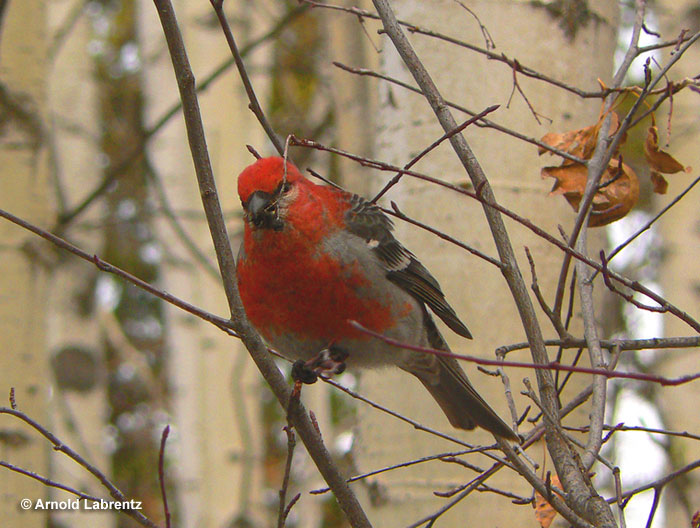Pine Grosbeaks (Pinicola enucleator) are vibrant, medium-sized finches found in the Northern Hemisphere. Males have beautiful rosy-red and gray plumage, while females are more subdued with gray and yellow tones.
In the United States, these slow but methodical foragers are not that common and can be mistaken for other finches, so here’s some information to help you determine which bird you saw.
On this page
Identification
Pine Grosbeaks are relatively large for a finch, measuring 8-10 inches long with a wingspan of 13 inches. They are chubby, have a round head with a thick dark gray cone-shaped bill, and a long, slightly notched tail.
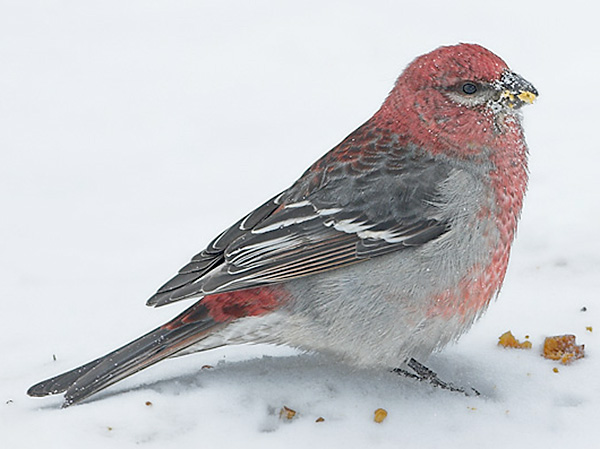
Male. Photograph © Glenn Bartley.
Male Pine Grosbeaks have red-gray-black plumage. Their head, chest and belly, sides, and back are reddish, and their lower belly and rump are gray. Immature males are grayish overall, with variable amounts of red or orange on their heads, chest, and rump. The color differs from region to region with the immatures on the coast generally having more red, but it is not definite.
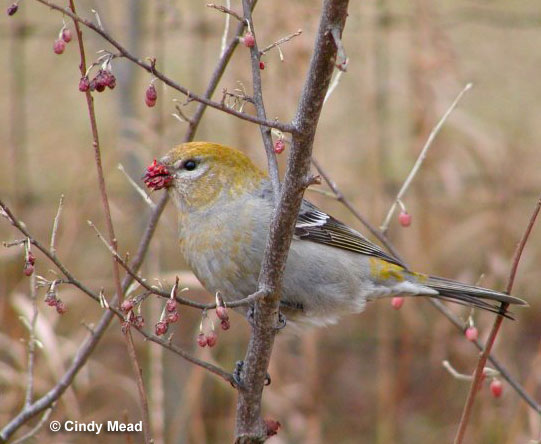
Female
Female Pine Grosbeaks have a more subdued appearance. They have yellow, almost golden chests, backs, and rumps, although the extent of yellow is variable. Their underside and wings are gray. Both sexes have black tails and blackish wings with two white wing bars. Juvenile Pine Grosbeaks look more similar to females but they’re duller, have less color, and look shaggy.
Vocalizations
Pine Grosbeak’s song is a soft flutelike warble that lasts for 2-5 seconds. You can often hear males singing from treetops. Females rarely sing.
However, both sexes call and it sounds rather similar to their song. It is a fairly simple warble that generally follows the tee-tee-tew pattern. Songs and calls vary slightly depending on their geographic location and individual birds, but interestingly enough, mated pairs have identical flight calls.
Food
Pine Grosbeaks primarily eat fruits, seeds, buds, and occasionally insects. During the breeding season in the summer, Pine Grosbeaks feed on a variety of fruits, including berries, cherries, and other soft fruits. They may forage in trees or on the ground for ripe fruits.
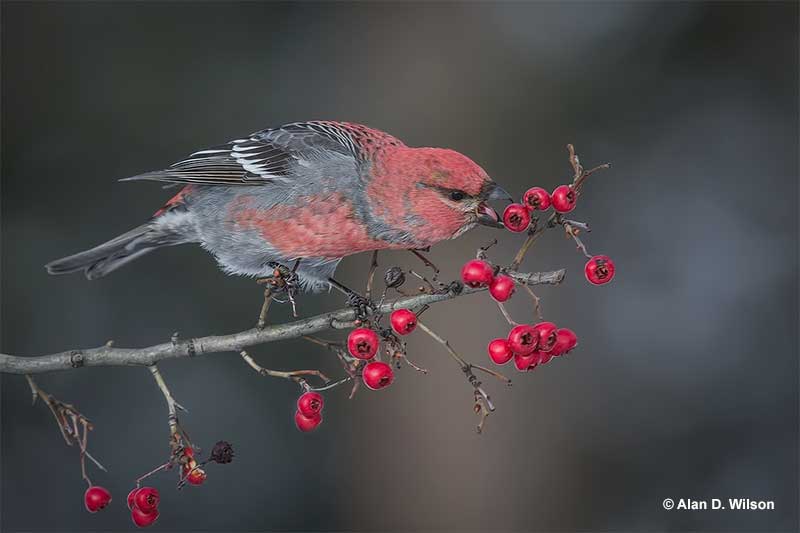
In the fall and winter, seeds become a more significant part of their diet. Pine Grosbeaks are particularly fond of the seeds of coniferous trees, such as pine, spruce, and fir.
They have strong bills that are adapted for cracking open seeds.
Pine Grosbeaks also consume buds, including from spruce, pine, mountain ash, maple, and others. While not a primary part of their diet, Pine Grosbeaks do eat insects, especially during the breeding season. Insects provide a protein-rich food source for both adult birds and their chicks.
Pine Grosbeaks are often found in small to large flocks, especially during the non-breeding season. They typically forage by hopping and climbing through trees and shrubs, using their powerful bills to extract seeds, fruits, and buds.
While foraging on the ground, Pine Grosbeaks may pick up fallen seeds and fruits. They also visit bird feeders, particularly those that have suet or sunflower seeds.
Nesting and Eggs
The breeding season for Pine Grosbeaks typically occurs in the spring and early summer, from April to July, depending on the geographic location. It is also influenced by the availability of food and weather conditions. They mate for life, with the male courting his partner by feeding her food.
The female is responsible for constructing the nest. She prefers to build them five to 15 feet above the ground in branch forks or on horizontal branches of mostly coniferous trees.
The nest is usually well concealed and often built near the trunk of the tree. However, they can also build them as low as two feet in shrubs.
Pine Grosbeak’s nest is a bulky cup made of twigs, bark, grasses, and other plant materials, lined with softer materials like moss or fine grass. It is about 3-4 inches deep and 6-9 inches across.
This species has only one brood per year with 2 to 5, usually 4 eggs in a clutch. Pine Grosbeak eggs are pale bluish-green with black, brown, and purple markings and about an inch long and under an inch wide. The mother bird incubates the eggs for 13-14 days while the male feeds her. Both parents are involved in feeding and caring for the chicks once they hatch.
After about 14 to 20 days, the chicks fledge and leave the nest but depend on their parents for food for another month or so.
Current Situation
Pine Grosbeaks range throughout northern Eurasia and North America, often found in boreal forests. In North America, Pine Grosbeaks are found across Alaska and northern Canada, extending southward into parts of the northern United States, including the Rocky Mountains, the Great Lakes region, and the northeastern United States.
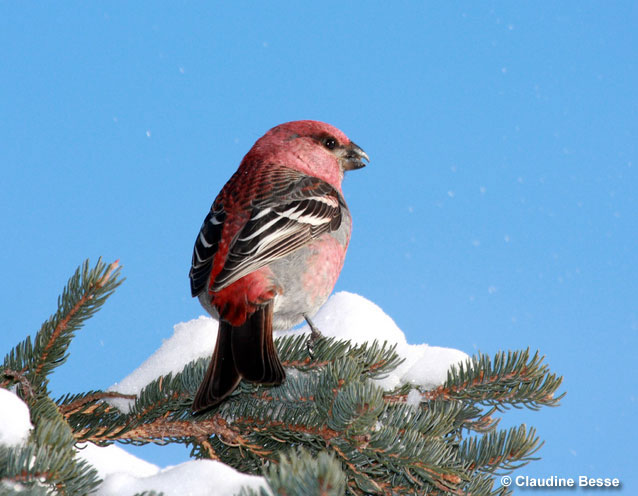
Pine Grosbeaks are considered partial migrants. While some individuals may stay in their breeding areas throughout the year, others, particularly those from more northern regions, may migrate south in the winter.
The extent of migration can vary based on factors such as food availability and weather conditions. In years with abundant food, some individuals may remain in their breeding areas even during the winter.
Pine Grosbeaks inhabit a variety of coniferous and mixed forests. They are often associated with spruce, pine, and fir trees, as these provide important food sources, including seeds and buds. During the breeding season, they may also be found in subalpine and alpine habitats, especially in mountainous regions.
Pine Grosbeaks are listed as of least concern on the IUCN Red List. They are fairly common throughout their range and have a global population of around 11 million.
Facts
- During the breeding season, both parents develop gular pouches (throat pouches) that help them bring more food to their offspring.
- Pine Grosbeaks have eight subspecies, of which 5 inhabit North America. Depending on their location and subspecies, their size, wing, and tail length, and also the amount, shade, and intensity of color varies.
- The average life expectancy of a Pine Grosbeak is around three to four years. The oldest specimen ever recorded lived for at least 9 years and 9 months.
Similar Species
Pine Grosbeaks look similar to various other species from the Finch family, including the White-winged Crossbill, Red Crossbill, House Finch, and Purple Finch. Here are some of the more similar ones and how to tell them apart.
White-winged Crossbill
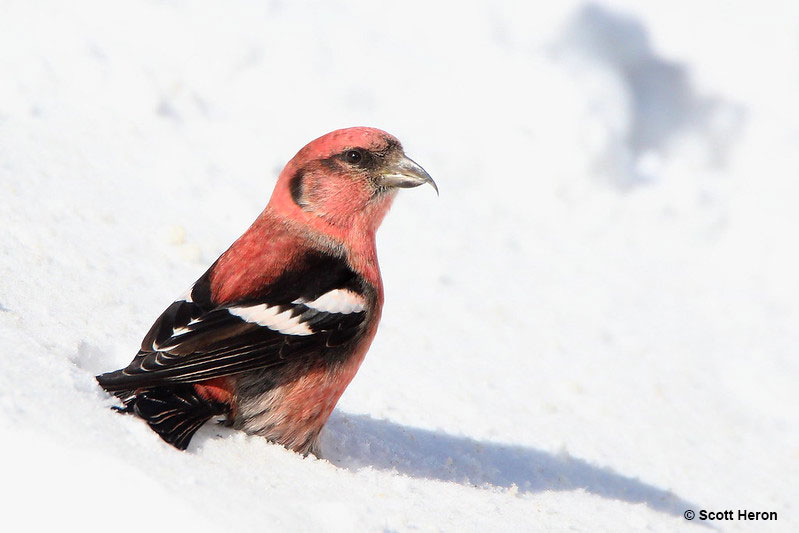
White-winged Crossbills have a very similar range to that of Pine Grosbeaks and they also prefer coniferous forests. Male White-winged Crossbills are red all over and have black wings with two white wingbars and black tails. Females are yellowish and brownish-gray with dark streaks covering their bodies. Their wings are also black with two white wingbars, but often only one of them is visible.
At a glance, they’re rather difficult to distinguish. However, the crossbill is smaller than the grosbeak and has a shorter tail. Their wings are darker black instead of gray, they have a streaked body, and the tips of their bills are criss-crossed.
House Finch
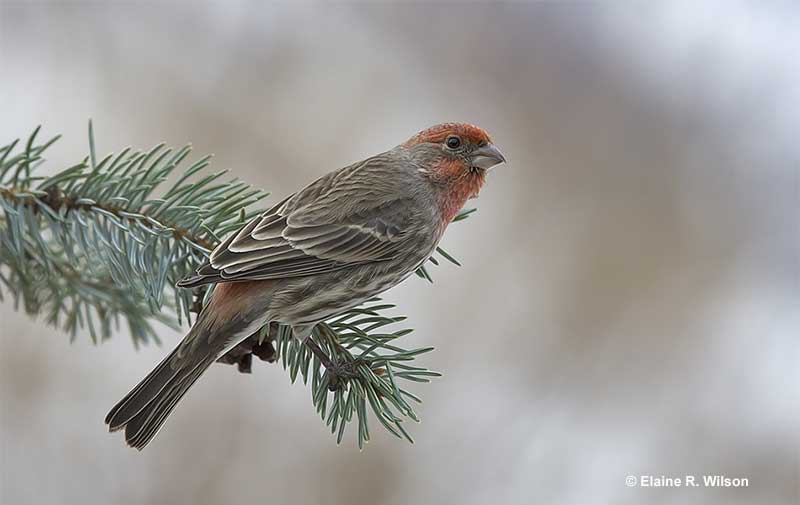
House Finches range throughout most of the United States, but can be found in Canada. They are only found in some southernmost regions. They are highly adaptable and can be found in a variety of habitats, including urban and suburban areas, grasslands, and open woodlands, whereas Pine Grosbeaks prefer coniferous forests.
Male House Finches have a ruby-red head. The color extends to their breasts and fades into pale brown. Their bellies, backs, and tails are also brown, streaked with dark brown. Females are brown overall with similar streaking. If you’re unsure which bird is which, look for streaking.
Purple Finch
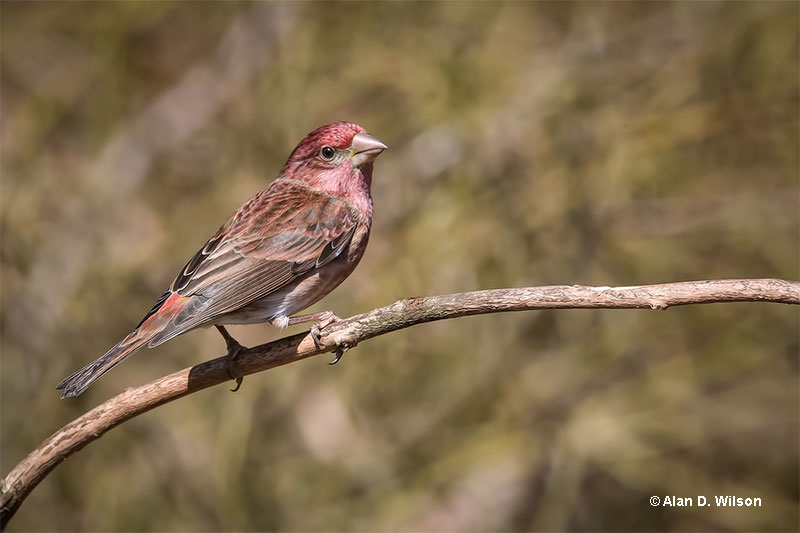
Purple Finches range throughout conifer and mixed forests of most of Canada, the coastal western United States, and the eastern United States. The birds look a bit different depending on the location, with the western variant sporting a darker red plumage.
Overall, males have raspberry-red heads, throats, breasts, and white bellies. Their wings also have red. However, they don’t have the two white wingbars Pine Grosbeaks have and instead of gray, their bellies are whitish.
Frequently Asked Questions
Are Pine Grosbeaks rare?
While Pine Grosbeaks are not rare, but meeting them in the United States is uncommon because their range only extends to the northernmost US.
What does a female Pine Grosbeak look like?
Female Pine Grosbeak is mostly gray with yellow on their head and rump. Their wings are gray with two white wingbars.
What is the difference between a house finch and a Pine Grosbeak?
The House Finch is smaller and adapts well to various habitats, including urban environments. Males have brown streaks and brown plumage instead of the gray the Pine Grosbeak has.
Are grosbeaks songbirds?
Grosbeaks are songbirds – their song is soft and flute-like.

